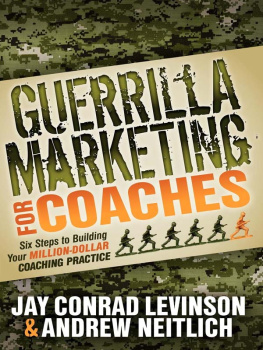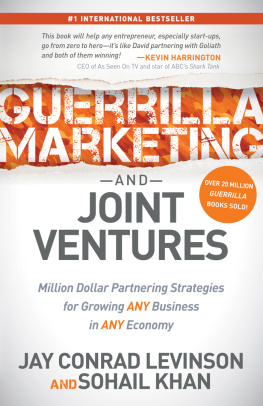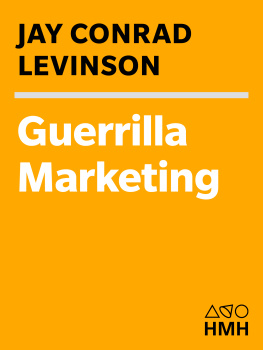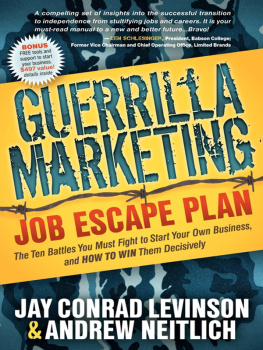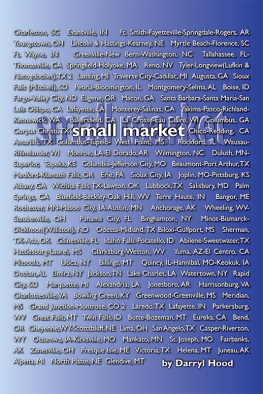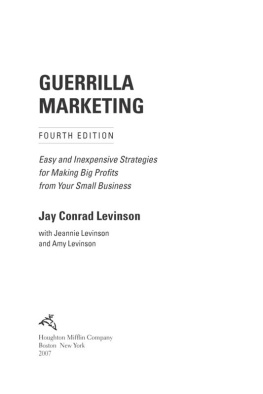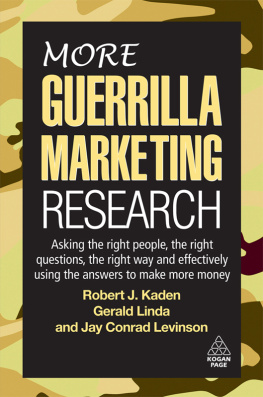Jay Conrad Levinson is the author of the best-selling marketing series in history, Guerrilla Marketing, plus 57 other business books. His books have sold 20 million copies worldwide. And his guerrilla concepts have influenced marketing so much that his books appear in 52 languages and are required reading in MBA programs worldwide.
Jay taught guerrilla marketing for 10 years at the extension division of the University of California in Berkeley. He was a practitioner of it in the United Statesas Senior VP at J. Walter Thompson, and in Europe, as Creative Director of Leo Burnett Advertising.
A winner of first prizes in all the media, he has been part of the creative teams that made household names of many of the most famous brands in history: The Marlboro Man, The Pillsbury Doughboy, Charlie the Tuna, Morris the Cat, Allstate's Good Hands, United's Friendly Skies, and the Sears Diehard Battery.
Jay is the Chairman of Guerrilla Marketing International. His Guerrilla Marketing is series of books, workshops, CDs, videos, a CD-ROM, a radio show, a University, a series of podcasts, an Internet landmark, and The Guerrilla Marketing Associationa support system for small business.
Guerrilla Marketing has revolutionized marketing because it is a way for business owners to spend less, get more, and achieve substantial profits.
To transform you into a marketing guerrilla, there is no better person than The Father of Guerrilla MarketingJay Conrad Levinson.
Guerrilla Business Secret #1:
How guerrillas start a company, pick a hot
product, and target a market
Let me tell you my own story.
First, I'll tell you how I failed. Then, I'll tell you how my failure led to an astonishing success.
I was sales manager for a publishing company. We recruited college students to sell books door to door during the summer. (I had paid my way through college by selling books and after graduation became a sales manager with the same company.)
After five years as sales manager, I got restless and talked to the top salesmen I had recruited and managed: Mike Rippey and Bill Roman. They were guerrillas from the very beginning. After they graduated, they decided to form a company. They looked around. What could they sell? They discovered a lot of companies who helped schools raise money by selling their products: candy, magazines, candles, and stadium seats.
They thought they could do the same thing with a different angle. Instead of mundane, boring products, they designed products that got kids excitedbig, bold, spectacular designs, much more thrilling than candy and magazines. They invited me to join them. I could not resist. I left my comfortable corporate world and became a guerilla.
One of our biggest hits was Happy Hang-ups, Styrofoam bulletin boards cut into interesting shapes. We silk-screened them with hilarious and friendly designs: turtles, frogs, hippos, and happy-face smiles. We used Day-Glo paint, so the bulletin boards were dazzling.
What a thrill it was to stand up in front of one hundred kids in a high school band, pull out the Happy Hang-ups, and listen to the kids scream with enthusiasm! A typical band of one hundred kids would sell four thousand or five thousand bulletin boards in one weekend at three dollars eachthe band made one dollar on each and paid us two dollars.
We started with four salespeople and quickly expanded to eight, then sixteen, then thirty-two. To grow to thirty-two we had to get a bank loan. The bank was impressed with our success and readily loaned us the money.
The thirty-two did not sell as much as the original fouronly half as much per salespersonbut even at that we were making lots of money. We were eager to go to the top, sell the company, and retire at age thirty.
So we decided to expand to 250 salespeople, a nationwide sales force covering all the high schools in the country. We talked the bank into lending us more money. We thought we could do no wrong, and we convinced the bank of the same.
Well, we found out that we could do wrong! The 250 salespeople sold half as much per salesperson as the thirty-two who had gone before them. We already had paid the salaries of the 250 salespeople in anticipation of great salessales that did not happen. We owed the bank and suppliersway too much. For the first time, we were unable to make our payments on time. We negotiated with our creditors, and they extended our terms. But the sales did not materialize. We ran out of cash. Brokenhearted, we closed the company.
In three short years we had gone from spectacular success to abysmal failure.
I'd been in business for myself for three years, but now I thought of going back to the corporate world. Still, the guerrilla bug had bitten, and I would never be able to work for someone else again.
Mike Rippey, Dennis Snyder, and I decided to try again, so we formed a new company. This time, we looked for a different type of salesperson, someone who had experience in the school system. We recruited principals, band directors, and coaches. We changed our product mix from large, bulky products, which were expensive to ship, to small, elegant products, like fashion jewelry that was easy to warehouse and ship.
We started again, with four salespeople, just like the first time. But this time we grew more slowlybut not all that slowly. We doubled our sales each year, from $1 million in 1979 to $60 million in 1985. Then we sold the company. For the first time in our lives, we had a healthy pile of cash in our bank accounts.
But we did not retire. Retirement had been our original goal, but we still were young, so we thought about other options. We concluded that nothing in the world was more interesting than running a guerrilla business. My friends and I have continued in business over the years, and we will never retire. We love the life of guerrilla entrepreneurs and will keep doing it, over and over again.
Why retire? There is nothing more fun than running your own guerrilla business. It's a constant adventureexhilarating, nerve-wracking, exciting, depressing, funny, sad, intense, and exuberant. You experience every emotion known to the human race except one:


